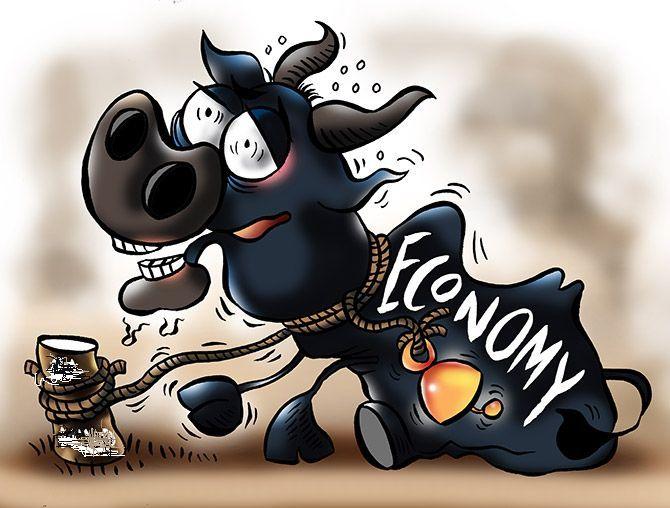The services sector, which plays the biggest role in shaping the economy, is facing loads of issues currently. The largest segments, financial and real estate, are struggling to cope with bad debts and low demand for houses.
Illustration: Uttam Ghosh/Rediff.com

After clocking a nine-quarter high of 8.2 per cent rate of GDP growth in the first quarter of 2018-19, the Indian economy is likely to slow in the quarters ahead.
Most agencies, including the government, the World Bank and the International Monetary Fund, have pegged the full-year growth rate at 7.3-7.5 per cent.
In such a situation, the growth rate of the country's GDP in the second quarter is likely to be 7.2-7.3 per cent.
Gross value added (GVA) is likely to grow 7.1-7.2 per cent during the quarter against 8 per cent in the first quarter on a lower rate of expansion in the agriculture and manufacturing sectors and a marginally higher rate in services. GDP growth may fall despite the services sector's domination of GVA at around 55 per cent.
The slippage may largely be due to the higher base effect of the second quarter of 2017-18.
In the first quarter of the current fiscal year, the growth rate was more than 8 per cent on a lower base of 5.6 per cent in the same period last year, which was due to the lingering impact of demonetisation and jitters over the imminent roll-out of the Goods and Services Tax (GST).
That 5.6 per cent growth rate was the lowest since the fourth quarter of 2013-14, when the economy expanded by 5.3 per cent.
However, the economy had grown by 6.3 per cent in the second quarter of 2017-18, because of which growth in the second quarter of the current fiscal year would look small compared to that in the first quarter.
The latest numbers are slated to be released on November 30.
If the economy grows by 7.3 per cent in the second quarter, the GDP rate in the first half of the current fiscal year would turn out to be 7.7 per cent against 5.9 per cent in the corresponding period in the previous fiscal year.
In any case, the growth rate will have to be 7.2 per cent in the second half of the current fiscal year if the economy is to achieve 7.5 per cent for FY19.
While Devendra Pant, chief economist at India Ratings, pegged the growth rate at 7.3 per cent for the second quarter of FY19, Aditi Nayar, principal economist at ICRA, put it at 7.2 per cent.
Pant forecast GVA growth at 7.2 per cent and Nayar at 7.1 per cent during this period.
Farm, manufacturing sectors may drag
Agriculture and allied activities grew 5.3 per cent in the first quarter against 4.5 per cent in the fourth quarter of 2017-18 and 3 per cent in the first quarter of that year.
However, the primary sector might yield 3-3.5 per cent in the second quarter.
Mostly horticultural produce is harvested in the second quarter, and kharif crops are sown during this period.
According to the first advance estimates of crop production, foodgrain production is expected to touch a record 141.6 million tonnes in the 2018-19 kharif season, up from 140.7 million tonnes last year.
However, its impact will be seen in the third quarter of the current financial year.
Growth in the first quarter of FY19 was driven primarily by manufacturing, which grew by 13.5 per cent against 9.1 per cent in the fourth quarter of 2017-18.
Sustaining double-digit growth in manufacturing for the second straight quarter may not be possible, and the figure might stand at 7.5 per cent this time around.
Against contraction in the first quarter of FY18, manufacturing grew by 7.1 per cent in the second quarter of that year.
This itself will make factory value addition look small in Q2 of FY19.
While companies in manufacturing have reported an uptick in sales, margins remained subdued.
It should be noted that the margin matters more in GDP these days than simple sales numbers.
While revenues rose substantially in some of these companies, net profit growth was subdued since companies were not able to pass on rising input costs to the customers.
Grey spots in the services sector
The services sector, which plays the biggest role in shaping the economy, is facing loads of issues currently.
The largest segments, financial and real estate, are struggling to cope with bad debts and low demand for houses.
However, affordable housing may provide a boost to realty in the second quarter.
The results that have come in so far show that while HDFC Bank and Axis Bank reported double digit-growth in net profit, ICICI Bank's net profit growth declined in second quarter of FY19, among private sector banks.
Among public sector banks, SBI's net profit declined, while scam-hit Punjab National Bank continued with a net loss due to higher provisioning for bad debts and subdued treasury operations.
Canara Bank posted double-digit growth in net profit, but that was mainly due to a tax write-off.
Among the NBFCs, both PNB Housing Finance and Indiabulls Housing Finance posted double-digit growth.
DHFL, which triggered a blood bath at the bourses due to liquidity issues, is yet to announce its results.
Other segments of the services sector include trade, hotels, transport and communication and broadcasting services, and government-supported public administration.
Growth in government-backed services during the second quarter will remain largely intact at 9.9 per cent, as in the first quarter.
Experts pegged overall growth in the services sector between 7.7 per cent and 8 per cent against 7.3 per cent in the first quarter.
Expenditure: A mixed bag
So far as the expenditure side of GDP is concerned, the estimation of numbers becomes complicated due to various proxies used.
Experts say growth in private final consumption expenditure may dip from 8.5 per cent in the first quarter to 8.4 per cent in the second.
Gross fixed capital formation, on the other hand, shows the investment rate in the economy may decline from 10 per cent in the first quarter to 8.7 per cent in the second quarter.
However, the government's final consumption expenditure may witness marginally higher growth than 7.5 per cent in the first quarter.











